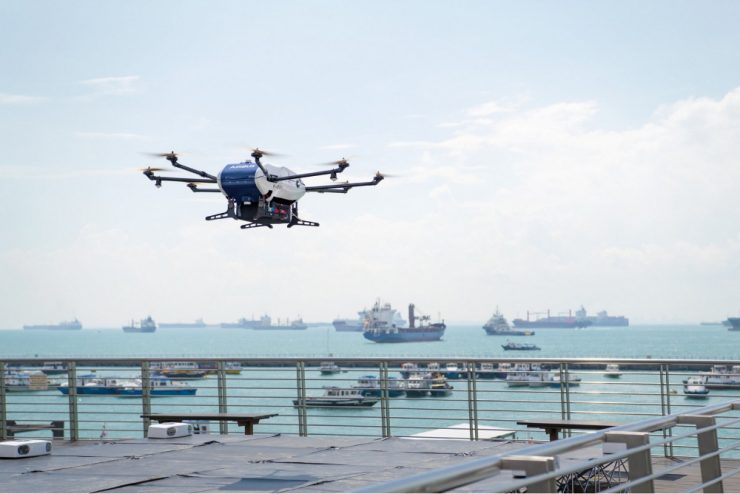Singapore’s Maritime and Port Authority MPA) is using standalone 5G networks to test coastal drone flights. The trials are being conducted in partnership with Infocomm Media Development Authority (IMDA), M1 Ltd and Airbus at the Singapore Maritime Drone Estate. This continues Singapore’s efforts to build an open and inclusive 5G innovative ecosystem around the use cases of port operations, and incident management and response.
According to a joint press release: IMDA, M1, MPA and Airbus plan to conduct 5G SA trials in real-world environments to ensure unmanned aerial vehicles can operate safely and efficiently during all phases of their flights, including operations in the designated drone-fly zones. The year-long trial extends up to 3km out to sea.
M1 will also be collaborating with TeamOne Technologies Pte Ltd, a local enterprise, to support the development of local capabilities within Singapore’s small and medium-sized enterprises. TeamOne aims to design and develop the world’s first aeronautical certified 5G SA communication modem for urban air mobility (UAM) operations. This 5G modem will be tested and optimised during the trials.
In addition to the coastal trials, M1 and Airbus have also signed a Memorandum of Understanding to conduct connectivity trials for in-land areas. This will enable M1 and Airbus to address the growing interest in unmanned aircraft systems (UAS) for UAM for other industries. All necessary permits and approvals will be sought from relevant agencies prior to the conduct of any flight trials.
5G trial objectives
As a communications company, M1 will provide 4G and 5G network planning, including data collection for performance and coverage analysis of mobile network in the operating areas, network parameter optimisation and implementation of interference minimisation methods. M1 will assess the use of 4G and 5G technologies to provide enhanced geo-location positioning information for all phases of UAS flight using network-based information, which is more precise than the current Global Navigation Satellite Systems (GNSS) technologies. Additionally, M1 will assess the network performance enhancement in connection stability, uptime and data throughput by aggregating seamlessly both 4G and 5G networks.
Previously, M1 and the Nanyang Technological University had conducted numerous successful trials to provide command, control and communication capabilities required for the safe and efficient drone operations using M1’s 4.5G networks. With the advent of 5G SA network supporting low-latency, responsive, secured and high-throughput mobile connectivity, cellular networks are expected to be able to provide even more precise, safe and reliable communications for the unmanned aircrafts.
Airbus, on its part, will provide a fleet of UAS for safe-flight testing and commit its expertise in the integration of the unmanned aircraft for the trials, ensuring that the UAS flight operations meet safety and regulatory requirements. The findings from these trials will help form a better understanding of evolving 5G standards, their feasibility and requirements for UAM applications, and future citywide UAS operations in Singapore’s urban and coastal environment. The establishment of a standard will open up the possibility for safe adoption of 5G as a core technology used in unmanned aircraft designs and operations.
“Given the growing need to create more efficient and sustainable solutions for the maritime industry, MPA supported the world’s first ship-to-shore drone delivery trial by Airbus and Wilhelmsen last year. We look forward to deepening the collaboration with Airbus and M1 to pilot innovative use cases for 5G technology in the maritime industry,” said Ms Quah Ley Hoon, Chief Executive, MPA.
“We are excited to partner with M1, IMDA and MPA to accelerate the development and adoption of UAM and Unmanned Traffic Management (UTM). This collaboration will establish key cellular 5G performance metrics and requirements to enable UAS to safely integrate and fly in national airspace systems. We look forward to combining our aerospace and UTM knowledge with M1’s technical expertise in the cellular industry, to enable the next age of aviation,” said Isabel Del Pozo De Poza, Head of UTM, Airbus.
(Image: Airbus UTM)
For more information visit:




